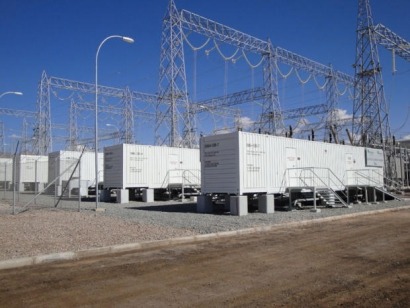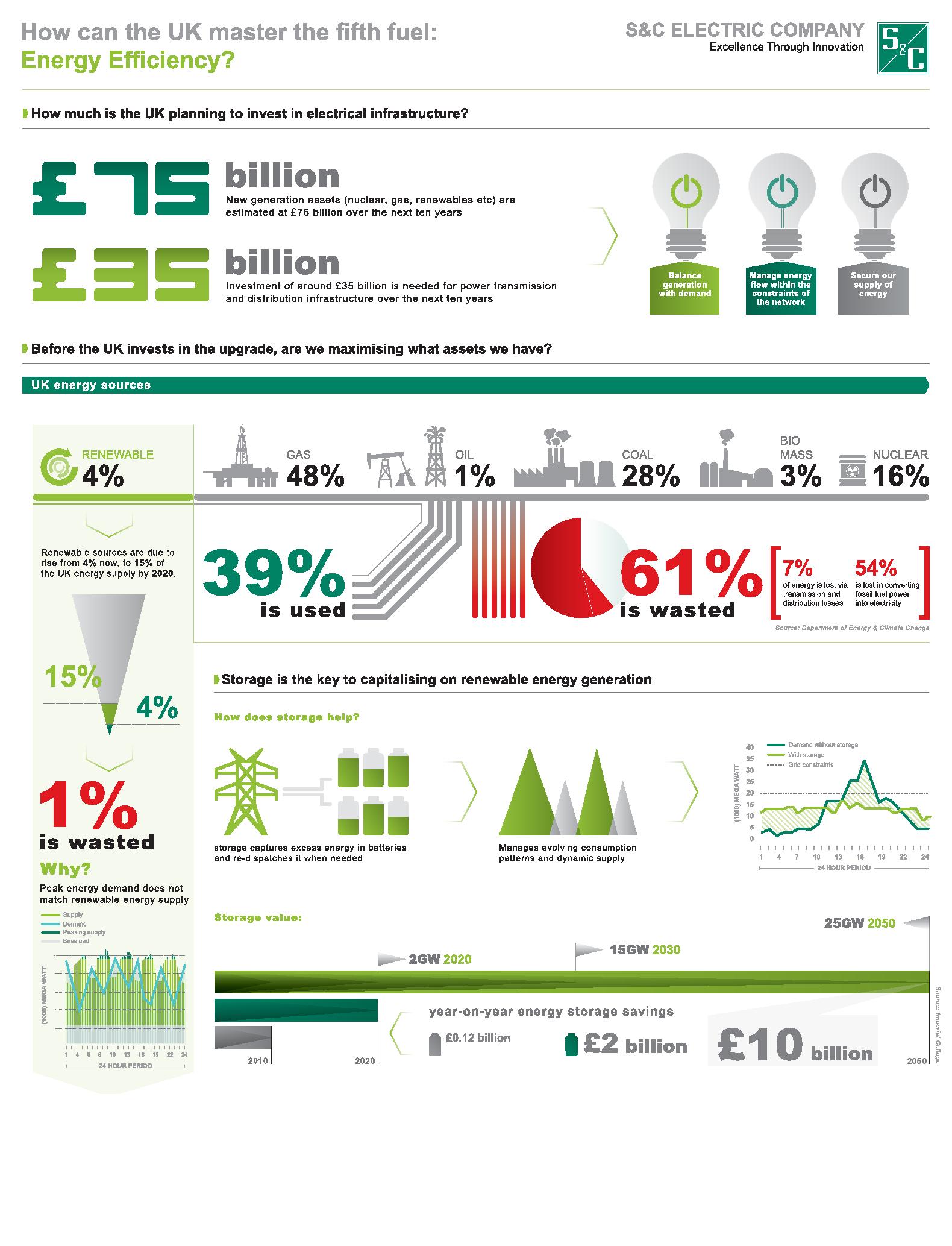
In this piece, Andrew examines why attention should be shifting away from energy generation towards saving energy through efficiency, and why energy storage is so crucial to a more sustainable energy landscape.
Take the main energy sources forming the UK energy mix. Coal and gas fired power stations emit damaging greenhouse gases - and must be transitioned away from. Nuclear is far cleaner, but its potentially threatening waste by-product makes it expensive to safeguard. Finally, renewable power is not always available when needed - as an energy source it is inherently intermittent - requiring voltage regulation to smooth the flow of energy to match the standards of supply that we’re used to.
The required investment in new generation assets is estimated at £75 billion over the next ten years[1] – which is a tall order even for a buoyant economy. I’m not saying that the move to clean energy generation is not necessary: it’s a vital step in maximising the UK’s long term assets. But shouldn’t we be limiting energy profligacy at the same rate as the development of generation to create more balanced supply and demand?
Mastering the negawatt
Our fifth energy source, energy efficiency, has yet to be mastered. Unlike generation, the only by-product of efficiency is wealth, in the form of less spending on power stations, cabling and infrastructure; cutting power generation and delivery costs, leading to lower fuel bills, as well as lower carbon emissions. Government has high ambitions for consumers to reduce their energy use through the smart meter roll from 2014. But smart meters don’t stop energy wastage, people do. Smart meter energy savings are somewhere between zero and 10%, depending on how well Government can engage the public in using them. My feeling is that reducing energy use at the grid level, before it reaches the consumer, is the more direct means of improving efficiency.
Of course, modernisation of the grid is no small task; investment of around £35 billion[2] is needed for power transmission and distribution infrastructure over the next ten years. A daunting figure in itself, although not half as daunting as the bill for generation.
Our aging grid infrastructure means that a colossal 61%[3] of energy is hemorrhaged just in the transmission from generator to customer. As well as the fundamental need to modernise the grid to prevent wastage, one of the critical factors for the successful renewables roll out is to maintain a safe and efficient balance between electricity supply and demand. Our existing grid is not equipped to temper the waves of variable energy from wind, solar and other domestic-scale renewables.
Energy storage, the Holy Grail of both efficiency and generation
The good news is that there’s a solution to the efficiency drain affecting both the grid and renewables, in the form of energy storage systems, which can make the grid strong and agile enough to handle what’s coming. By placing energy storage devices at key points throughout the grid, utilities can manage evolving consumption patterns and dynamic supply, while deferring or even eliminating traditional capital expenditures into the future.
Essentially, storage increases the production and output of renewable energy generation; so we need fewer generation plants overall and are less dependent on carbon-emitting plants. It does this by enabling an efficient flow of power on the network; preventing wastage. Storage solves multiple problems including smoothing output, storing excess energy in distributed batteries, and re-dispatching that power during peak load times, as well as enabling longer periods of operation at higher output.
These efficiencies on renewable generation rapidly add up. A Boston Consulting Group recently valued the Internal Rate of Return (IRR) of energy storage at 7% rising to 30%[4]. Also, distributed energy storage enables generation technologies to be installed at the end user, which in turn reduces the need to invest in power delivery infrastructure to deliver electricity and also reduces wastage lost from centralised plants to the end user. Having the ability to store energy at source can also limit the need for installation of electricity distribution infrastructure, such as transformers, cables and overhead lines.
A recent report by Imperial College[5], found that the value of storage will progressively increase towards 2050. Should storage deployment grow from 2 GW in 2020 to 15 and 25 GW in 2030 and 2050 respectively, the equivalent system savings increase from £0.12bn per year in 2020 to £2bn and reaching over £10bn per year in 2050.
At present there is little storage capability on the UK network, the principal capacity being around 2,800 MW of pumped hydro-electricity storage, which can store approximately 27,000 MWh (2.5% of daily average electricity production). National Grid estimates suggest that our requirement will rise to 8,000 MW in 2025[6]. So, with storage being of paramount importance to both efficiency and generation, why is competition not driving further take-up sooner?
The broken value chain
The problem holding back investment in storage is a distortion between supply and demand, brought about by lack of knowledge sharing between the four key stakeholders: generators, transmission system operators, distributors, and supply companies. With each part of the chain only responsible for a narrow segment, around 30%, of the grid, it’s hard to put a ‘value’ on efficiency as the efficiency gains are split four ways. The broken value chain originates from Ofgem’s efforts to make the market competitive by putting Chinese walls in place, in the form of financial penalties, preventing stakeholders from communicating. This is ironic, since the difficulty for companies to own and gain value from storage is slowing down the efficiency of renewables, which is a key barrier to the UK’s exportation of these technologies.
One way to solve this would be for a change in policy to make electricity storage a separate market category from generation, transmission, distribution and supply. Fortunately, Government and industry are working together to prove the value of storage at each level of the value chain. Recently, the Department of Energy and Climate Change (DECC) called upon S&C and other organisations in our space to help to investigate the realistic requirements for electricity storage across the power system and to realistically determine its corresponding value to the UK.
With so much to be gained by preventing energy wastage, as well as generation, the Government’s Electricity Market Reform (EMR), which is currently examining and revising the commercial and regulatory structure of the nation’s electricity market, should take into account the unique nature of electricity storage and remunerate investors and operators accordingly. Fundamentally, to justify the investment in an effective transition to the low carbon economy, we need to couple investment in clean energy generation with systemic change in the way that energy is delivered and stored.
The following infographic shows the key stats cited in this article.

[Inset: A123's utility-scale energy storage technology installed at a site in Chile]
References
[1] DECC, Planning our electric future: a White Paper for secure, affordable and low carbon electricity, July 2011 (HM Government, London, 2011)
[2] Ofgem, Project Discovery, February 2010
[3] Digest of UK energy statistics 2011. DECC
[4] Revisiting Energy Storage.The Boston Consulting Group, February 2011
[5] Strategic Assessment of the Role and Value of Energy Storage Systems in the UK Low Carbon Energy Future, (imperial College July 2012)
[6] National Grid, Operating the Electricity Transmission Networks in 2020, June 2011
For additional information:

